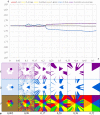Fractal dimension complexity of gravitation fractals in central place theory
- PMID: 36759669
- PMCID: PMC9911407
- DOI: 10.1038/s41598-023-28534-y
Fractal dimension complexity of gravitation fractals in central place theory
Abstract
Settlement centers of various types, including cities, produce basins of attraction whose shape can be regular or complexly irregular (from the point of view of geometry). This complexity depends in part on properties of the space surrounding a settlement. This paper demonstrates that by introducing a dynamic approach to space and by including an equation of motion and space resistance, a dramatic change in the stylized static CPT (Central Place Theory) image occurs. As a result of the interplay of gravitational forces, basins of attraction arise around cities, whose boundaries appear to be fractals. This study provides a wealth of spatial fractal complex images which may change the traditional understanding of CPT.
© 2023. The Author(s).
Conflict of interest statement
The authors declare no competing interests.
Figures








Similar articles
-
Fractal morphometry of cell complexity.Riv Biol. 2002 May-Aug;95(2):239-58. Riv Biol. 2002. PMID: 12449683
-
Self-Organisation in Spatial Systems-From Fractal Chaos to Regular Patterns and Vice Versa.PLoS One. 2015 Sep 24;10(9):e0136248. doi: 10.1371/journal.pone.0136248. eCollection 2015. PLoS One. 2015. PMID: 26402913 Free PMC article.
-
Self-similarity and fractal irregularity in pathologic tissues.Mod Pathol. 1996 Mar;9(3):174-82. Mod Pathol. 1996. PMID: 8685210 Review.
-
Spatial behavior analysis at the global level using fractal geometry.Nonlinear Dynamics Psychol Life Sci. 2008 Jan;12(1):3-13. Nonlinear Dynamics Psychol Life Sci. 2008. PMID: 18157924
-
Lung cancer-a fractal viewpoint.Nat Rev Clin Oncol. 2015 Nov;12(11):664-75. doi: 10.1038/nrclinonc.2015.108. Epub 2015 Jul 14. Nat Rev Clin Oncol. 2015. PMID: 26169924 Free PMC article. Review.
References
-
- Christaller W. Die Zentralen Orte in Suddeutschland. Jena: Fisher; 1933.
-
- Berry BJL. The Geography of Market Centers and Retail Distribution. Prentice Hall; 1967.
-
- Parr JB, Denike K. Theoretical problems in central place analysis. Econ. Geogr. 1970;46(4):568–586. doi: 10.2307/142941. - DOI
-
- Mulligan GF, Partridge MD, Carruthers JI. Central place theory and its reemergence in regional science. Ann. Reg. Sci. 2012;48(2):405–431. doi: 10.1007/s00168-011-0496-7. - DOI
-
- van Meeteren M, Poorthuis A. Christaller and "big data": Recalibrating central place theory via the geoweb. Urban Geogr. 2017;39(1):122–148. doi: 10.1080/02723638.2017.1298017. - DOI
LinkOut - more resources
Full Text Sources
Research Materials

